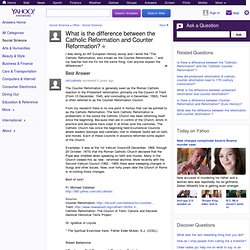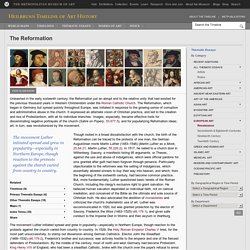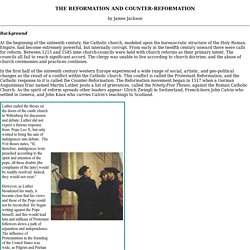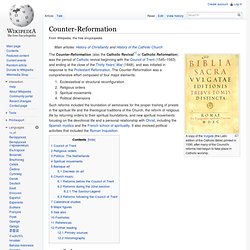

THE COUNTER REFORMATION. In the sixteenth century the Roman church undertook to reform itself.

This reform movement, extending into the following century, raised the moral and educational standards of the clergy; inspired the church with a renewed zeal and morale, which enabled it to win back areas endangered by Protestantism; and contributed significantly to producing the Catholic church as we know it today. The chief agencies in carrying out this work were the papacy, which was much different from the papacy of the Renaissance; a group of religious orders, some reformed and some new, most notably the Society of Jesus, or Jesuits; and the Council of Trent.
What is the difference between the Catholic Reformation and Counter Reformation. The Counter Reformation is generally seen as the Roman Catholic reaction to the Protestant reformation; primarily via the Council of Trent (From 13 December, 1545, and concluding on 4 December, 1563).

Trent is often referred to as the Counter Reformation Council. From my research there is no one point in history that can be pointed to as the Catholic Reformation. The term Catholic Reformation is problematic in the sense the Catholic Church has been reforming itself since the beginning. Because men are in control of the Church, errors in practice and discipline have crept in at times over the centuries. The Catholic Church has since the beginning held Ecumenical Councils where leaders (bishops and cardinals) met to interpret God's will on faith, and morals. Examples: it was at the 1st Vatican Council(8 December, 1869, through 20 October, 1870) that the Roman Catholic Church declared that the Pope was infallible when speaking on faith and morals.
Best of luck! Fr. St. Robert Bellarmine St. The Reformation. Unleashed in the early sixteenth century, the Reformation put an abrupt end to the relative unity that had existed for the previous thousand years in Western Christendom under the Roman Catholic Church.

The Reformation, which began in Germany but spread quickly throughout Europe, was initiated in response to the growing sense of corruption and administrative abuse in the church. It expressed an alternate vision of Christian practice, and led to the creation and rise of Protestantism, with all its individual branches. Images, especially, became effective tools for disseminating negative portrayals of the church (Satire on Popery, 53.677.5), and for popularizing Reformation ideas; art, in turn, was revolutionized by the movement. Though rooted in a broad dissatisfaction with the church, the birth of the Reformation can be traced to the protests of one man, the German Augustinian monk Martin Luther (1483–1546) (Martin Luther as a Monk, 20.64.21; Martin Luther, 55.220.2). The Catholic Counter-Reformation. The Reformation and Counter Reformation. THE REFORMATION AND COUNTER-REFO.
By James Jackson Background At the beginning of the sixteenth century, the Catholic church, modeled upon the bureaucratic structure of the Holy Roman Empire, had become extremely powerful, but internally corrupt.

From early in the twelfth century onward there were calls for reform. Between 1215 and 1545 nine church-councils were held with church reforms as their primary intent. The councils all fail to reach significant accord. Counter-Reformation. A copy of the Vulgate (the Latin edition of the Catholic Bible) printed in 1590, after many of the Council's reforms had begun to take place in Catholic worship.

The Counter-Reformation (also the Catholic Revival[1] or Catholic Reformation) was the period of Catholic revival beginning with the Council of Trent (1545–1563) and ending at the close of the Thirty Years' War (1648), and was initiated in response to the Protestant Reformation. The Counter-Reformation was a comprehensive effort composed of four major elements: Ecclesiastical or structural reconfigurationReligious ordersSpiritual movementsPolitical dimensions Council of Trent[edit] A session of the Council of Trent, from an engraving. Pope Paul III (1534–1549) initiated the Council of Trent (1545–1563), a commission of cardinals tasked with institutional reform, addressing contentious issues such as corrupt bishops and priests, indulgences, and other financial abuses. Religious orders[edit] Politics: The Netherlands[edit]